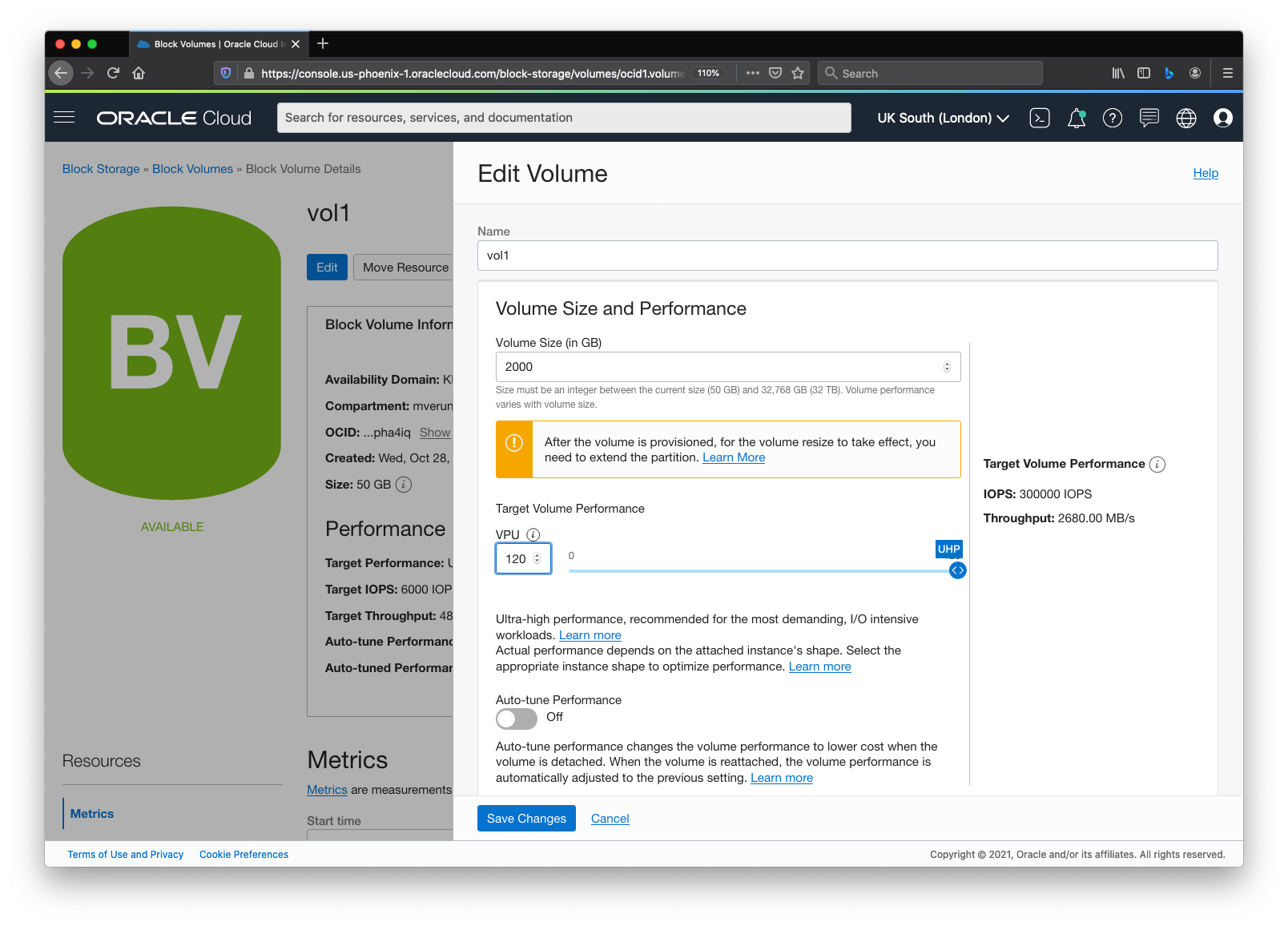Oracle Cloud Infrastructure (OCI) has been at the forefront of block storage performance since we launched in 2016. During those periods when others managed to surpass our performance lead, we maintained the best price-performance in the public cloud. Today, we retake the performance lead with new performance options, still provide the best price-performance, and seamlessly improve our Block Volume service offering, all while maintaining one easy-to-use flexible volume type.
We’re excited to announce that Ultra-High-Performance (UHP) block volumes with up to 300,000 IOPS and 2,680 MB/s throughput per volume are now generally available across all OCI commercial regions and on all interfaces: Console, API, SDK, CLI, and Terraform. UHP volumes support all features of OCI Block Volume service. You can take advantage of this performance on any supported compute instance shape and operating system today.
In addition to these new UHP options, we’re increasing the performance of our existing Higher Performance option, from maximum 35,000 IOPS to 50,000 IOPS and from maximum 480 MB/s to 680 MB/s throughput per volume, with no increase in price.
One block volume, many flexible performance options
As higher and higher performance options for block storage emerged on other cloud platforms, most clouds introduced new, disparate volume types, tiers, and pricing models. Today, other clouds offer a complex set of volume types and tiers that need cumbersome and careful planning and conversion process to provision storage properly or to move between tiers. We’ve learned from that trend and avoided this complexity with our second-generation cloud storage from the beginning.
We offer one flexible volume type with a simple performance slider to control it: Volume Performance Units per GB (VPU/GB). This setting configures volume performance on demand, and you can adjust it dynamically without unmounting, migrating, or otherwise disturbing the volume or the application using it. This approach uses the performance unit model introduced at Oracle OpenWorld 2019, as part of the flexible storage infrastructure announcements and keynotes from Larry Ellison and Clay Magouyrk.
Provision the storage and VPU/GB setting you need, and both IOPS and throughput come together without need for further optimization for each. Start anywhere on the performance slider and change it anytime you need. You don’t need to carefully study, understand, plan, and select performance tiers and prices, because we don’t have any of that complexity. All types of application workloads get the same guaranteed performance, whether they’re read-heavy such as streaming applications, write-heavy such as IOT applications, sensory and log data collection, or a read/write mix such as enterprise transactional database systems.
We offered initially three flexible performance and price options with ability to add more in the future seamlessly. We labeled them Lower Cost, Balanced, and Higher Performance. Per gigabyte storage price is the same across all these options ($0.0255/GB per month retail), while the performance can be optionally and dynamically added or removed through the VPU/GB setting. Each VPU/GB is $0.0017/GB-month and can be configured in increments of 10 VPU/GB: 0 VPU/GB for Lower Cost (maximum 3,000 IOPS/volume), 10 VPU/GB for Balanced (maximum 25,000 IOPS/volume), and 20 VPU/GB for Higher Performance option (maximum 35,000 IOPS/volume).
UHP options with simple, linear pricing
Aligned with the existing VPU/GB model, we’re now extending the flexible infrastructure performance slider to cover higher VPU/GB settings up to 120 VPU/GB in 10-unit increments, providing up to 300,000 IOPS and 2,680 MB/s per volume. All the new options are labeled under UHP with seamlessly varying VPU/GB levels.
We still provide a single, uniformly scaling performance and price model across the board. Per-gigabyte and maximum performance scale factors for IOPS and throughput per volume scale linearly, predictably, and seamlessly with VPU/GB values across the entire range. You don’t have tiers and complex pricing to manage. You can continue to change the performance of any volume instantaneously by updating the VPU/GB setting on the flexible performance slider anytime and as frequent as you like while it’s attached and without any impact to your running applications. All these features come to you at the best price and simplicity from OCI Block Volume service among all cloud storage providers.
A linear and predictable formula correlates VPU/GB value to volume IOPS and throughput performance characteristics. For any VPU/GB setting and volume size, you can easily see the performance achievable and guaranteed for your volume on the Console or calculate it for your volumes and manage them dynamically as you demand, using API, SDK, CLI, and Terraform. All performance settings have the same submillisecond latency that you expect from our all NVMe-SSD based cloud storage, except the Lower Cost option.
Adjusting the performance of a volume in your Console experience is as simple as using a slider on the Edit Volume dialog. The following example shows a 2,000 GB block volume configured to achieve 300,000 IOPS and 2,680 MB/s throughput easily with the flexible performance slider.

Performance levels and SLA
We continue to guarantee performance, except the Lower Cost option, with the financially backed performance service level agreement (SLA) that is available only from OCI.
Starting with the Balanced option (10 VPU/GB) as the baseline, each extra 10 VPU/GB increment adds the following performance over the previous VPU/GB level:
-
+ 15 IOPS/GB scale
-
+ 25,000 IOPS for maximum IOPS per volume limit (up to maximum 300,000 IOPS at 120 VPU/GB)
-
+ 120 KB/s/GB throughput scale
-
+ 200 MB/s for maximum MB/s per volume limit (up to maximum 2,680 MB/s at 120 VPU/GB)
You can also calculate performance characteristics using the following linear formulas for any VPU/GB setting (starting from balanced 10 VPU/GB, in increments of 10 VPU/GB up to 120 VPU/GB):
-
IOPS/GB = 1.5*VPU/GB + 45
-
Maximum IOPS per volume = 2,500*VPU/GB
-
KB/s/GB = 12*VPU/GB + 360
- Maximum MB/s per volume = 20*VPU/GB + 280
| Performance option | VPU/GB | IOPS/GB | Maximum IOPS/Volume | Volume size for maximum IOPS (GB) | KB/s/GB | Maximum throughput/Volume (MB/s) | $Price/GB-month (Retail) | ||
| Storage | Performance | Total | |||||||
| Lower Cost | 0 | 2 | 3,000 | 1,500 | 240 | 480 | $0.0255 | $0.0000 | $0.0255 |
| Balanced | 10 | 60 | 25,000 | 417 | 480 | 480 | $0.0255 | $0.0170 | $0.0425 |
| Higher Performance | 20 | 75 | 50,000 | 667 | 600 | 680 | $0.0255 | $0.0340 | $0.0595 |
| UHP | 30 | 90 | 75,000 | 833 | 720 | 880 | $0.0255 | $0.0510 | $0.0765 |
| 40 | 105 | 100,000 | 952 | 840 | 1,080 | $0.0255 | $0.0680 | $0.0935 | |
| 50 | 120 | 125,000 | 1,042 | 960 | 1,280 | $0.0255 | $0.0850 | $0.1105 | |
| 60 | 135 | 150,000 | 1,111 | 1,080 | 1,480 | $0.0255 | $0.1020 | $0.1275 | |
| 70 | 150 | 175,000 | 1,167 | 1,200 | 1,680 | $0.0255 | $0.1190 | $0.1445 | |
| 80 | 165 | 200,000 | 1,212 | 1,320 | 1,880 | $0.0255 | $0.1360 | $0.1615 | |
| 90 | 180 | 225,000 | 1,250 | 1,440 | 2,080 | $0.0255 | $0.1530 | $0.1785 | |
| 100 | 195 | 250,000 | 1,282 | 1,560 | 2,280 | $0.0255 | $0.1700 | $0.1955 | |
| 110 | 210 | 275,000 | 1,310 | 1,680 | 2,480 | $0.0255 | $0.1870 | $0.2125 | |
| 120 | 225 | 300,000 | 1,333 | 1,800 | 2,680 | $0.0255 | $0.2040 | $0.2295 | |
For example, for a 1-TB volume with 100,000 IOPS requirement, you pay $25.50/month for storage and $68/month for performance—a total of $93.5/month, or $1,120/year. We suggest that you compare this example and your specific needs to the options you have on other cloud providers.
Performance is a volume property, but the maximum achievable performance may also be limited by the compute instance the volume is attached to. With this announcement, only Linux instances support UHP performance. All bare metal instances can achieve UHP performance of maximum 300,000 IOPS per volume. Virtual machines iSCSI attachments achieve up to 300,000 IOPS. Virtual machines paravirtualized attachments achieve up to 150,000 IOPS per volume and are limited to E4 shapes for this initial release. OCI Block Volumes performance page provides more detail.
With this release, we also enable in-transit encryption for bare metal instances, for which the throughput for existing Higher Performance option is initially increased from prior 480 MB/s to 540 MB/s per volume with no increase in price, and soon will also be updated to 680 MB/s per volume.
Use cases and flexibility
Our flexible cloud storage architecture already allows application and system builders to automatically and dynamically adjust performance of their volumes through API, CLI, SDK, Terraform, and Console. Workloads that have seasonal or event-based spikes, such as promotions and sales during holidays or special events, can benefit from flexible UHP storage with dynamic adjustment capability.
For example, retail business sector customers greatly benefit from the flexible storage infrastructure that we provide. During seasonal events, such as Thanksgiving in United States and holidays sales from November to January every year, their load spikes significantly where 80% to 200% ramp up in site traffic, transactions, and sales are common. This feature helps them to dynamically address the spike by dialing up the performance of block storage temporarily only during these events. They pay only for extra performance during these seasonal spikes, and after the load calms down, they lower the performance of their volumes for cost savings for most of the year.
A continuous integration and delivery (CI/CD) pipeline for cloud native application development is another common use case. During demanding build and deployment cycles, you can increase the performance of your volumes temporarily and scale them down when you don’t need that level of high performance.
Our public cloud customers with their custom applications, our Oracle products such as Fusion, CRM, ERP, HR workloads, E-Business Suite, and software- and platform-as-a-service (SaaS and PaaS) applications all benefit from the flexible storage infrastructure that OCI provides.
Try it for yourself
We want you to experience these new features and all the enterprise-grade capabilities that OCI offers. It’s easy to try them out with Oracle Cloud Free Tier. For more information on taking advantage of these performance updates and UHP capability, see the Oracle Cloud Infrastructure storage portfolio, Block Volume service overview, ultra-high-performance (UHP) volumes, Block Volume performance, performance levels, and attaching UHP volumes.
We value your feedback as we continue to make our service the best in the industry. More feature updates and advancements are on the horizon for our cloud storage platform. Send your thoughts on how we can continue to improve or if you want more details about any topic.
